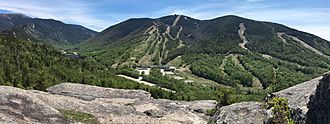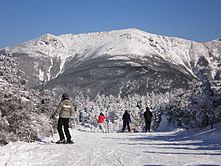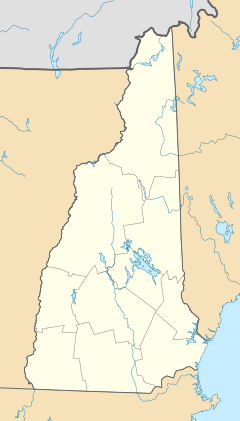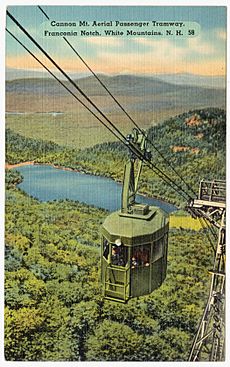Cannon Mountain Ski Area facts for kids
Quick facts for kids Cannon Mountain Ski Area |
|
|---|---|

Cannon Mountain as seen from the top of the Bald Mountain
|
|
| Location | Franconia, New Hampshire, |
| Nearest city | Franconia |
| Coordinates | 44°09′28″N 71°41′56″W / 44.15778°N 71.69889°W |
| Vertical | 2330 ft (710 m) Cannon/Mittersill |
| Top elevation | 4180 ft (1274 m) Cannon |
| Base elevation | 1850 ft (564 m) Mittersill |
| Skiable area | 265 acres (1.1 km²) |
| Runs | 73 Plus Mittersill Backcountry Area (86 acres) |
| Longest run | 2.3 miles (3.7 km) |
| Lift system | 10 total: - Aerial tram (70) - 1 hi-speed quad chair - 2 quad chairs - 3 triple chairs - 1 double chair - 1 rope tow - 1 Wonder Carpet |
| Lift capacity | 11,000 skiers/hour |
| Snowfall | 160 in (4.1 m) |
| Snowmaking | 168 acres (0.68 km2) |
Cannon Mountain Ski Area is a popular ski resort in New Hampshire, USA. It's owned by the state and sits on Cannon Mountain in the beautiful White Mountains. The resort is part of Franconia Notch State Park.
Cannon Mountain offers 10 lifts and has 265 acres (1.07 km2) of skiable terrain. About 168 acres (0.68 km2) of this area has snowmaking. The mountain has 23 miles (37 km) of trails. It's special because it has the only aerial tram in New Hampshire. Cannon also has the biggest vertical drop in New Hampshire, at 2,330 feet (710 m). This makes it the seventh largest ski area in New England. Famous US Olympic skier Bode Miller learned to ski here.
Contents
History of Cannon Mountain
Building the First Tramway
Cannon Mountain was home to North America's very first passenger aerial tramway. This special lift carried people up the mountain. It was built in 1938 and ran until 1980. During that time, over 6.5 million passengers rode the tram.
The idea for the tram came from Alexander Bright. He was a skier who helped develop the sport in the area. In 1933, he saw passenger trams in Europe while on the US Olympic Ski Team. He realized a tram in New Hampshire could help skiing and summer tourism grow.
Bright convinced a company to study building a tram. In 1933, a survey was done in Franconia Notch. Roland Peabody, a local expert, helped with the survey. He was very excited about developing recreation in the White Mountains.
Choosing the Location
In 1934, a committee looked at seven possible places for the tram. They chose Cannon Mountain. One main reason was that building a tram there would not harm the beautiful scenery. It also needed only a small amount of forest to be cut. Plus, the area was already a popular spot for tourists.
Legislation to build the tram was passed in 1935. But the project faced a problem when federal money was not available. In 1937, a new bill was passed. Governor Francis P. Murphy signed it into law. This allowed a $250,000 bond to pay for the tram. Roland E. Peabody was then named the Managing Director.
Construction and Opening
Construction began quickly in August 1937. A company called American Steel Wire Company won the building contract. At the same time, a group of 200 men from the CCC started working. They built a parking area and developed ski trails. Some old logging roads had been used for skiing since 1929. The famous Richard Taft Race Course was developed in 1931-1932.
To build the passenger tram, a freight tram was needed first. This carried heavy materials like cement and steel. Workers carried cement and other supplies by backpack. This difficult job was finished in December. Construction continued through the winter. Most of the work was done by hand. This included pouring 32 carloads of cement. Workers also put together 232 tons of steel and four miles (6 km) of cable. It was seen as an amazing engineering achievement for its time.
On June 28, 1938, North America's first aerial tramway opened. This was just nine months after construction started.
The opening attracted many people from across the country. Newspapermen, photographers, and newsreel cameramen came. Lowell Thomas even broadcasted news from the tram stations. The tram quickly became a major tourist spot. It carried 163,000 passengers in its first year.
The tram proved to be a good investment for the state. It also showed that skiing could be a successful industry in New Hampshire. Cannon Mountain became a top ski destination in the East. Its success encouraged private businesses to invest. This helped the ski industry in New Hampshire grow.
The New Tramway
By 1965, officials realized the original tramway would need to be replaced. Even though it was well-maintained, replacement parts were expensive. Also, the tram's capacity was limited. In 1977, the New Hampshire legislature approved a replacement project.
In July 1978, a contract was given to Nuova Agudio. Construction began that month. The lower station was finished by April 1979. Helicopters were used briefly in the summer of 1979 to lift large parts. Unlike the first tram, the existing tram could be used to move materials up the mountain. Construction continued even with many summer visitors.
The new tramway passed tests in February 1980. It was approved for passengers. The Cannon Mountain Aerial Tramway II travels 5,359 feet (1,633 m) up the mountain. It has two cabins, each holding 80 passengers. They travel at 1,500 feet (460 m) per minute. This means it can carry 1,540 passengers per hour. This is more than three times the capacity of the old tram.
Mittersill Ski Area
Until 1984, another part of Cannon Mountain was called Mittersill Ski Area. This area is on the north-northwestern side of the mountain. The main Cannon Mountain Ski Area is on the north-northeastern side. Skiers who know the area often use Mittersill's trails. They are easy to reach with a short hike.
In the late 1990s and early 2000s, New Hampshire planned to buy the Mittersill area. The goal was to use its trails to expand Cannon Mountain. The purchase was completed in 2008. A new double chairlift was ordered for the 2010-2011 ski season.
Ski Trails at Cannon Mountain
Cannon Mountain has trails for all skill levels.
Beginner and First-timer Trails (21%)
The Tuckerbrook Quad Chair serves beginner trails. These include Bear Paw, Deer Run, Fleitmanm, and Coyote Crossing. These trails are separate from the upper mountain. The lower part of Cannon has four long runs for beginners. These are Lower Cannon, Parkway, Gremlin, and Turnpike. You can easily reach this area using the Eagle Triple Chair.
The Brookside learning area is a special place for new skiers. It is separate from the rest of the mountain. It has its own triple chairlift and two surface lifts. This allows new skiers to learn and then move to nearby beginner trails.
Intermediate Trails (47%)

Even though Cannon is known for expert trails, it has many slopes for intermediate skiers. From the top, trails like Vista Way, Tramway, and Upper Cannon wind through the forest. These connect to other intermediate runs. Examples include Middle Cannon and Middle Ravine. The Cannonball Express Quad is another option. The Tram Cutback is an intermediate way to get back to the tram.
Expert and Advanced Trails (32%)
Expert trails at Cannon Mountain are challenging. DJ's Tramline is a narrow trail with steep sections. It needs a lot of snow to cover rocks and cliffs. This trail has been called one of the "Gnarly 10 Toughest Trails in the East."
Cannon Mountain uses Black Diamond for its expert trails. While some trails might be considered "double black diamond" at other mountains, Cannon rates them relative to its own slopes. Skiers should always be careful on new "advanced" or "experts only" runs.
Avalanche is the steepest run, with a 31-degree slope. Paulie's Folly and Hard Scrabble also have steep sections. The Mittersill area offers unique "sidecountry" skiing. This means it has many glades (trails through trees) and mogul runs (trails with bumps). Kinsman Glade is one of the longest glades in the East.
The Front Five trails are reached from Paulie's Extension or Lower Cannon. Three of them—Avalanche, Paulie's Folly, and Zoomer—are black diamond. The other two, Rocket and Gary's, are less steep. From the summit, you can find trails like Cannonball, Skylight, or Upper Ravine.
Awards and Recognition
In 2013, SKI Magazine gave Cannon Mountain high praise. It was named #1 in New Hampshire for value, challenge, lifts/lift service, and overall satisfaction. The magazine also listed Cannon in the Top 10 in the East for value, access, challenge, character, lifts/lift service, and overall satisfaction.
Rentals and Ski School
The Brookside Learning Center offers programs for kids. These include full-day and half-day youth programs. Childcare is also available for babies six months and older. Seasonal programs are offered too.
Cannon Mountain has a full-service PSIA Ski and Snowboard School. PSIA stands for Professional Ski Instructors of America. Ski shops are located at the Peabody Base Lodge and Tram Base. You can rent skis and snowboards at the Peabody Base Lodge. All rental skis are "shaped" skis, and snowboards have "step in" bindings. A High Performance Tuning Center is also at the Peabody Base Lodge.




